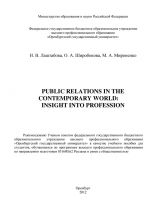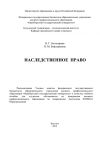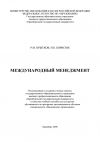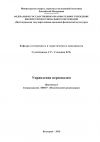Правообладателям!
Представленный фрагмент книги размещен по согласованию с распространителем легального контента ООО "ЛитРес" (не более 20% исходного текста). Если вы считаете, что размещение материала нарушает ваши или чьи-либо права, то сообщите нам об этом.Читателям!
Оплатили, но не знаете что делать дальше?
Текст бизнес-книги "Public Relations in the contemporary world: Insight into Profession"
Автор книги: Ольга Широбокова
Раздел: Иностранные языки, Наука и Образование
Текущая страница: 1 (всего у книги 2 страниц)
Лаштабова Н. В., М. Мироненко, Ольга Широбокова
Public Relations in the contemporary world: Insight into Profession
Введение
«Public Relations in the contemporary world: Insight into Profession» – учебное пособие к углубленному курсу иностранного (английского) языка имеет целью систематизацию и обобщение материала по истории развития связей с общественностью в современном англоязычном мире для формирования коммуникативных навыков.
Данное учебное пособие предназначено для студентов-бакалавров второго курса факультета журналистики очной и заочной формы обучения. Оно может быть использовано в качестве основного средства обучения, содержащего практический материал по углубленному курсу изучения иностранного (английского) языка.
Настоящее пособие посвящено истории развития средств массовой информации с древнейших времен до наших дней, а также особенностям функционирования связей с общественностью за рубежом. Все представленные в данном пособии темы снабжены упражнениями и практическими заданиями, необходимыми для тренировки коммуникативных навыков и усвоения материала по данным темам. Пособие также содержит материал об особенностях написания и оформления писем, статей, резюме, эссе на английском языке.
1 History of the media
1 . Read the proper names and say what you know about them. If they are unknown for you, find some information in the text.
John Peter Zenger
Sir William Cosby
Thomas Paine
Benjamin Day
Joseph Pulitzer
William Randolph Hearst
2 . Read and translate the text
History of the media
America's earliest media audiences were quite small. These were the colonies’ upper class and community leaders – the people who could read and who could afford to buy newspapers. The first regular newspaper was the Boston News-letter, a weekly started in 1704 by the city's postmaster, John Campbell. Like most papers of the time, it published shipping information and news from England. Most Americans, out in the fields, rarely saw a newspaper. They depended on travelers or passing townsmen for this news.
When rebellious feelings against Britain began to spread in the 1700s, the first battles were fought in the pages of newspapers and pamphlets. Historians consider the birth of America's free-press tradition to have begun with the 1734 trial of John Peter Zenger. Zenger, publisher of the New York Weekly Journal, had boldly printed stories that attacked and insulted Sir William Cosby, the colony' unpopular royal governor.
Cosby ordered Zenger's arrest on a charge of seditious libel. As the King's representative, royal governors had the power to label any report they disliked – true or not – "libelous," or damaging to the government's reputation and promoting public unrest. Zenger's lawyer, Andrew Hamilton, argued that "the truth of the facts" was reason enough to print a story. The American jury agreed, ruling that Zenger had described Cosby's administration truthfully.
Perhaps one of America's greatest political journalists was one of its first, Thomas Paine. Paine's stirring writings, urging independence made him the most persuasive "media" figure of the American Revolution against Britain in 1776. His pamphlets sold thousands of copies and helped mobilize the rebellion.
By the early 1800s, the United States had entered a period of swift technological progress that would mark the real beginning of "modern media." The inventions of the steamship, the railroad and the telegraph brought communications out of the age of windpower and horses. The high-speed printing press was developed, driving down the cost of printing. Expansion of the educational system taught more Americans to read and sparked their interest in the world.
Publishers realized that a profitable future belonged to cheap newspapers with large readerships and increased advertising. In 1833 a young printer named Benjamin Day launched the New York Sun, the first American paper to sell for a penny. Until then, most papers had cost six cents. Day's paper paid special attention to lively human interest stories and crime. Following Day's lead, the press went from a small upper class readership to mass readership in just a few years.
It was a time that shaped a breed of editors who set the standard for generations of American journalists. Many of these men were hard-headed reformers who openly sided with the common man, opposed slavery and backed expansion of the frontier. They combined idealism with national pride, and their papers became the means by which great masses of new immigrants were taught the American way of life.
Competition for circulation and profits was fierce. The rivalry of two publishers dominated American journalism at the end of the century. The first was Joseph Pulitzer (1847 – 1911), a Hungarian immigrant whose Pulitzer prizes have become America's highest newspaper and book honors. His papers, the St. Louis Post-Dispatch and the New York World, fought corporate greed and government corruption, introduced sports coverage and comics, and entertained the public with an endless series of promotional stunts. By 1886 the World had a circulation of 250,000, making it the most successful newspaper up; to that time.
The second publisher was William Randolph Hearst (1863-1951), who took Pulitzer's formula to new highs – and new lфws – in the San Francisco Examiner and the New York Journal Hearst's brand of outrageous sensationalism was dubbed "yellow journalism" after the paper's popular comic strip, "The Yellow Kid." Modern media critics would be horrified at Hearst's coverage of the Spanish-American War over Cuba in 1898. For months before the United States declared war, the Journal stirred public opinion to near hysteria with exaggerations and outright lies. When Hearst's artist in Cuba found no horrors to illustrate, Hearst sent back the message:
"Please remain. You furnish the pictures and I'll furnish the war."
Pulitzer and Hearst symbolized an era of highly personal journalism that faded early in this century. The pressure for large circulation created one of today's most important press standards: objective, or unbiased, reporting. Newspapers wanted to attract readers of all views, not drive them away with one-sided stories. That meant editors began to make sure all sides of a story were represented. Wider access to the telephone helped shape another journalistic tradition: the race to be first with the latest news.
The swing to objective reporting was the key to the emergence of The New York Times. Most journalists consider the Times the nation's most prestigious newspaper. Under Adolph S. Ochs, who bought the paper in 1896, the Times established itself as a serious alternative to sensationalist journalism. The paper stressed coverage of important national and international events – a tradition which still continues. Today the Times is used as a major reference tool by American libraries, and is standard reading for diplomats, scholars and government officials.
The New York Times is only one of many daily newspapers that have become significant simpers of public opinion. Among the most prominent are The Washington Post, the Los Angeles Times, the Boston Globe, and the Christian Science Monitor. The Miami Herald, for instance, responded to the needs of its city's influx of Spanish-speaking residents by presenting extensive coverage of Latin America and printing a separate Spanish edition. Satellite technology has made possible the first genuinely nationwide newspapers – from the sober, thorough business paper, the Wall Street Journal, to the bright colors and personality orientation of USA Today.
Another recent phenomenon is the proliferation of supermarket tabloids, weeklies sold chiefly at grocery store check-out lines. Although they look like newspapers, these publications carry little hard news and stress items about celebrities, human interest stories about children and pets, and diet and health tips. The leading tabloid, the National Enquirer, claims a circulation of more than 4,000,000.
The total number of daily newspapers in the United States is shrinking – from 1748 in 1970 to 1,642 in 1988. In 1923, there were 503 communities with more than one daily newspaper. By 1988, only 49 cities had more than one paper. There are several reasons for this trend. The movement of people from cities to suburbs led to the demise of some city dailies and the creation of weekly suburban newspapers that emphasized local community happenings and drew revenues from local advertisers. And members of busy households in which both husband and wife worked outside the home found they had less time to read and often stopped buying an afternoon newspaper. But the most important reason was probably the growing popularity of television. While newspapers are read in 62 million of the nation's 91 million households, 98 per cent of all American homes are equipped with at least one television. And a Roper Organization poll found that 65 per cent of Americans use television as their primary source of news. Since newspapers cannot report the news as quickly as radio and television, many papers have changed their emphasis, concentrating on features, personality profiles and in-depth news analysis rather than fast-breaking headline stories.
3 . Translate and transcribe the following words, learn them by heart. Find the sentences where they were used and write them out.
Audience, to afford, postmaster, rebellious, pamphlet, to attack, to insult, representative, to label, reputation, lawyer, political, to urge, persuasive, telegraph, communication, expansion, profitable, advertising, frontier, idealism, circulation, rivalry, outrageous, sensationalism, “yellow journalism”, exaggeration, prestigious, significant, satellite technology, celebrity, tabloid, suburban, emphasis.
4 . Fill in the gaps using the words from the given below. Change the form if necessary.
Suburban, celebrity, “yellow journalism”, pamphlet, telegraph, postmaster, prestigious, advertising, satellite technology, circulation.
1. When … was invented, communication was changed forever.
2. The newspapers, that contain news about celebrities are called …
3. Publishers quickly realized the profit of … and increased it.
4. John Campbell was a … in Boston, who started the first regular newspaper.
5. The most important factor in getting profit from a newspaper is its …
6. News about … and politicians always attracted the public attention.
7. The development of computers and … brought the media to a new level.
8. The local community events which are of small importance for city-dwellers are published in … newspapers.
9. Time is considered the most … newspaper of all times.
10. In 1700s the battles based on the rebellious feeling against Britain brought to life … on pages of the newspapers.
5 . Find the English equivalents for the following phrases:
Лидер общин, информация о доставке, бунтарский дух, битвы на страницах газет, традиция свободной прессы, королевский губернатор колонии, арест по обвинению в клевете, наклеить любой ярлык, вредить репутации губернатора, содействовать проявление общественного недовольства, правдиво описывать, взволнованные статьи, продаваться многотысяным тиражом, подогревать возмущение, быстрое технологическое развитие, снижать стоимость печати, увеличивать количество рекламы, выпускать газеты стоимостью 1 пенни в продажу, привлекать внимание к невымышленным историям и преступлениям, настоящие реформаторы, выступать против рабства, внедрять в печать новости о спорте, комиксы, сместить акцент.
6. Match the definitions with the words


7 . Answer the questions.
1. Why did the news spread slowly in America’s first colonies?
2. What was the first regular newspaper? Who was the editor?
3. Who were the greatest America’s political journalists of the XVIII century?
4. How did the swift technological progress influence the press?
5. Why did the publishers increase advertising?
6. Why was William Randolph Hurst considered a prominent publisher?
7. Why has the New York Times become one of the most significant newspapers?
8. What are the reasons of the shrinking number of newspapers in the USA?
8. Say how these dates are connected with the history of the media.
1. 1704
2. 1734
3. Early 1800
4. 1833
5. 1896
6. 1988
9. Translate the following phrases. Pay attention to the use of prepositions. Find the sentences where they were used in the text and read them out.
On a charge for
To depend on smb for smth
To enter _ a period
To belong to
To pay attention to
To fight _ government corruption
To be horrified at smth
The reason for smth
To be equipped with smth
10 . Fill in the prepositions.
1. He depends … his journalists … the latest news coverage.
2. A famous politician was arrested … a charge … bribery.
3. In 2000 the media entered … a period of information technologies.
4. In the XIX century the public’s view belonged … the cheap newspapers.
5. It’s important to pay special attention … lively human interest stories and the crime.
6. St. Louis Post-Dispatch fought … corporate greed and government corruption.
7. Media critics often are horrified at the amount of crimes coverage in most newspapers.
8. The reason … most of the publication trends in journalism are connected with money and celebrities.
9. Practically every home is equipped … at least one TV set.
11 . Read the quotations, translate and comment on them.
Start your phrase with:
Example:” Joseph Pulitzer, who introduced the techniques of “new journalism”, said:…”
Find some information about the personality if necessary.
Joseph Pulitzer (1847-1911).
“An able, disinterested, public-spirited press, with trained intelligence to know the right and courage to do it, can preserve that public virtue without which popular government is a sham and a mockery”.
William Randolph Hearst (1863-1951).
“Don't be afraid to make a mistake, your readers might like it”.
Benjamin Day (1810-1889).
“Well, I want you to know how much I appreciate this. Really”.
2 The press in the Roman Empire and in medieval Europe
1 . Read the proper names and titles and say what you know about them. If they are unknown for you, find some information in the text.
Julius Caesar
Richard Fawkes
Acta Diurna
The Venetian Republic
The Mercurius Gallobelgious
Herald
Express
Observer
Guardian
Standard
Argus
2 . Read and translate the text
The Roman Empire. The urge to inform the public of official developments and pronouncements had been a characteristic of most autocratic rules. This urge was fulfilled in ancient Rome by the Acta Diurna ("Daily Events"), a daily gazette dating from 59 ВС and attributed in origin to Julius Caesar. Handwritten copies of this early journal were posted in prominent places in Rome and in the provinces with the clear intention of feeding the populace with official information. The Acta Diurna was not, however, restricted to proclamations, edits, or even to political decisions taken in the Roman Senate, the actions of which were reported separately in the Acta Senatus (literally "Proceedings of the State"). The typical Acta Diurna might contain news of gladiatorial contests, astrological omens, notable marriages, births and deaths, public appointments, and trials and executions. Such reading matter complemented the usual fare of military news and plebiscite results also given in the Acta Diurna and presaged the future popularity of such newspaper filler and horoscopes, the obituary column, and the sports pages.
Medieval Europe. In Europe, the impetus for regular publications of news was lacking for several centuries after the break up of the Roman Empire. The increased output of books and pamphlets made possible by the development of the printing press in the 16th century did not include any newspapers, properly defined. The neatest form was the newssheet, which was not printed but handwritten by official scribes and read aloud by town criers. News was also contained in the news pamphlet, which flourished in the 16th century as a means of disseminating information on particular topics of interest. One such pamphlet, printed in England by Richard Fawkes, and dated September 1513, was a description of the Battle of Flodden Field. Titled "Trew Encountre", this four-leaved pamphlet gave an eyewitness account of the battle together with a list of the English heroes involved. By the final decade of the 15th century, publication of newsbooks was running at more than 20 a year in England alone, matching a regular supply on the Continent. Authors und printers escaped official censorship or penalty by remaining anonymous or cultivating a certain obscurity for it took a long time before the pamphlets came to the attention of the authorities. In any case the topics most frequently chosen for coverage – scandals, feats or heroism or marvelous occurrences – were mainly nonpolitical and could not be regarded as a threat to the powerful. Governments in various Countries were already in the vanguard of news publishing for propaganda purposes. The Venetian republic set a precedent by charging an admission fee of one gazeta (3/4 – three fourths of a penny) to public readings of the latest news concerning the war with Turkey (1563), this recognizing a commercial demand for news, even on the part of the illiterate. The term gazette was to become common among latest newspapers sold commercially. Another popular title was to be Mercury (the messenger of the gods). The Mercurius Gallobelgicus (1588 – 1638) was among the earliest of a number of periodical summaries of the news that began to appear in Europe in the late 16th century. Newspaper names like Mercury, Herald and Express have always been popular, suggesting the immediacy of freshness of the reading matter. Other names, such as Observer, Guardian, Standard and Argus stress the social role played by the newspapers in a democratic society. Newspaper development can be seen in three phases: first, the sporadic forerunners, gradually moving towards regular publications; second, more or less regular journals but liable to suppression and subject to censorship and licensing, and, third, a phase in which direct censorship is abandoned but attempts at Control continue through taxation, bribery and prosecution. Thereafter, some degree of independence has followed.
3 . Translate and transcribe the following words and expressions, learn them by heart. Find the sentences where they were used and write them out.
Pronouncement, handwritten copy, to restrict, proclamation, appointment, to compliment, development, printing press, newssheet, to disseminate, eyewitness account, final decade, to escape censorship, to remain anonymous, a threat to the powerful, to be in the vanguard of news, to set a precedent, to charge an admission fee, to recognize a commercial demand for news, illiterate, title, periodical, regular publication, to abandon, bribery.
4 . Fill in the gaps using the words from the given below. Change the form if necessary.
Development, eyewitness, to compliment, bribery, to remain anonymous, proclamation, final decade, to set a precedent, illiterate, periodical.
1. The readers could meet with an …account of the battle in “Trew Encountre”.
2. The news about the war with Turkey …: the gazette was charged an admission fee for reading the news.
3. The Acta Diurna accepted … and also published the news about the political decisions in the Roman Senate.
4. The 16th century invention of the printing press made the … of the books very quick.
5. Even the … people in Venice had a great desire to know the latest news.
6. In the 16th century there were very few … newspapers that published the summaries of the news.
7. The usual news … the information about the births and deaths, notable marriages and public appointments.
8. The control over the newspapers was taken by means of taxation, … and prosecution.
9. Many authors remained … in order to avoid punishment and pursuit.
5 . Find the English equivalents for the following phrases:
Ежедневная газета, значимые места, четкое намерение, политические решения, поединки гладиаторов, распад Римской империи, городские глашатаи, процветал в 16 веке, свидетельства очевидца, избегать цензуры и наказания, чудесное событие, угроза властьимущим, коммерческий спрос на новости, свежесть и актуальность материала для чтения.
6. Match the definitions with the words.

7 . Answer the questions.
1. What is the country where the first press appeared?
2. What was the first handwritten journal?
3. Which news was described in the Acta Diurna?
4. Did the Acta Diurna describe only social news or military news as well?
5. What was the reason of the break up of the news regular publication?
6. Was the newssheet a written or printed copy?
7. What was a news pamphlet?
8. What was “Trew Encountre”?
9. How did most authors escape censorship in the Middle Ages?
10. What gazette did the Venetian republic charge a fee for?
11. What were most popular titles for the gazettes?
12. Why was the term “gazette” used instead of a “newspaper”?
13. What are the three phases of newspaper development?
8 . Translate the following phrases. Pay attention to the use of prepositions. Find the sentences where they were used in the text and read them out. To date from (59 BC) To attribute in origin to smb To contain news of contests The impetus for smth A means of disseminating information On particular topics of interest An account of the battle In any case A degree of independence.
9 . Fill in the proper prepositions.
1. The archaeologists found a clay plate, dating … 30 BC, but concluded that it was a fake.
2. The earliest gazette attributed … origin … Julius Caesar.
3. An ancient gazette contained news … notable marriages, public appointments and trials.
4. The impetus … regular publications was lacking due to several reasons.
5. A gazette was a means …disseminating information written in a form of a pamphlet.
6. Only the news … particular topics … interest, such as politics, battles, marriages could appear in the medieval gazette.
7. “Trew Encountre” countained an account … the battle and the list of heroes involved.
8. …any case the topics for publications were more or less similar: scandals, heroism or marvelous occurrences.
9. In the Middle Ages the degree… independence in the press was high due to the fact that many authors were anonymous.
10 . Comment on the following quotations:
Albert Camus (1913-1960)
“A free press can of course be good or bad, but, most certainly, without freedom it can never be anything but bad… Freedom is nothing else but a chance to be better, whereas enslavement is certainly of the worse”
Thomas Jefferson (1743-1826)
“The press is the best instrument for enlightening the mind of man, and improving him as a rational, moral and social being”.
Franklin D. Roosevelt
“If in other lands the press and books and literature of all kinds are censored, we must redouble our efforts here to keep them free”.
Правообладателям!
Представленный фрагмент книги размещен по согласованию с распространителем легального контента ООО "ЛитРес" (не более 20% исходного текста). Если вы считаете, что размещение материала нарушает ваши или чьи-либо права, то сообщите нам об этом.Читателям!
Оплатили, но не знаете что делать дальше?







